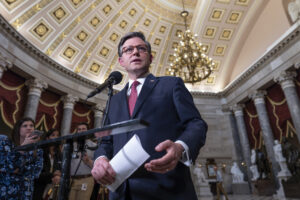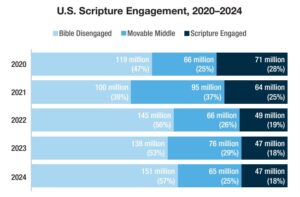
BIRMINGHAM, Ala. (BP)–Emotional goodbyes and anticipated new beginnings were sounded in the agency reports of the Home Mission Board, Brotherhood Commission and Foreign Mission Board during the annual Woman’s Missionary Union executive board meeting that began Jan. 11 in
Birmingham, Ala.
Wally Buckner, assistant to the president at the HMB, started the HMB report by thanking WMU for its support and for telling the home missions story. WMU had “literally saved (us) from extinction at some points,” Buckner said. “Because of this rich legacy, I can stand here and call you our friend.”
Ernest Kelley, HMB interim president, said, “The Home Mission Board has no greater friend than WMU.
“No matter what changes the future will bring, home missions and home missionaries will rely on the support of the women in churches,” he said.
Next year home missions will be coordinated by the North American Mission Board, which will consolidate the functions of the HMB, Brotherhood Commission and Radio and Television Commission under the restructuring of the Southern Baptist Convention, “Covenant for a New
Century.” NAMB officially comes into existence July 1 of this year.
Also delivering an emotional farewell report was James Williams, Brotherhood Commission president. Thanking WMU “prayer warriors” for their unceasing prayer support during the transition, Williams asked for continued prayer — that NAMB will receive full acceptance, prayer and
financial support from the Southern Baptist family.
“The birthing of NAMB is closing the doors on the soon-to-be 90-year-old Brotherhood Commission,” Williams said. “I have nothing but the highest praise for our staff, trustees and state leaders, all who have worked diligently — doubly hard, really — to see that our work goes forward,” he said, noting Brotherhood’s largest annual growth increase, of 16 percent, occurred in 1996.
Williams called it a privilege to stand with Dellanna O’Brien, executive director of WMU, during his five and a half years at the Brotherhood Commission in trying to model partnership in missions education.
Linkages and partnerships will become more significant as the SBC moves away from a rather monolithic structure to more of a confederation, Williams said.
“That means we must lay aside our vested interests and
organizational elitism and recognize the whole is always more than the sum of its parts,” he said, urging WMU to keep on task with its missions focus. “Keep on doing well what you are doing well, and keep on walking hand in hand with the North American Mission Board and the Foreign
Mission Board.”
Williams said coordination and planning specifics of NAMB’s relationship with WMU and other entities in the area of missions education are still being worked out. The Logistics Transition Team, designated by the Implementation Task Force to develop the plan for the structure of NAMB, along with 20 sub-teams, is sifting through data to
discover better ways of organizing the new board, said Williams, an LTT member.
Kelley said missions education will be a strong part of NAMB, but the level of the relationship between NAMB and WMU is yet to be determined. The missions education functions of the Brotherhood Commission will only be strengthened once they become part of NAMB, Kelley said.
“I believe the North American Mission Board will be more productive and efficient in reaching America for Christ,” Kelley said, adding that efficiency comes with consolidation. Noting the transition will not be easy for anyone, Kelley said he is committed to restructuring. “It is good for Southern Baptists as well as home missions,” he stated.
Williams reported there will be five process groups of NAMB, not offices. The groups will be evangelism, church starting, media and missions education, planning and mobilization, and business support group. “The latter three groups will give support to the primary strategies of evangelism and church starting,” Williams said.
With the LTT’s work virtually complete, information on staffing and position identifications should soon be made public, Williams said, noting it must first be approved by the ITF. “The current population of the three existing agencies exceeds 500,” he said. The LTT is currently working on assignments to reduce the head count to 325, he stated. The media and missions education group holds the largest number of staff members right now, he noted.
However, an ITF spokesperson said Jan. 20 that the total count will be about 350 rather than the 325.
HMB workers across the country with missionary status should not be effected in any of the structure changes, Kelley added.
Delivering the final report of the Foreign Mission Board came much easier for Jerry Rankin, FMB president. Although the name will change to International Mission Board as of July 1, there will be no changes in the agency.
Rankin reported the International Mission Board is about what God is doing overseas. “We really are being driven by a vision,” he said, noting the agency’s goal of having an IMB representative assigned to every mega-people group by 1998. The SBC agency also seeks to have 1,000
missionaries in China and India and 1,000 journeymen overseas by the year 2001, Rankin said.
While no new staff or departments are being added to the IMB under the SBC restructuring, significant shifts in the work with churches are being made, Rankin said in an interview with The Alabama Baptist following the FMB report. Mobilization will be shaping IMB products and events, he said, citing more focused and usable video products. The Commission magazine is also more user-friendly, Rankin said. “We are trying to facilitate what anybody and everybody is doing in missions education,” Rankin said. “The network is out there — state conventions, the volunteer partnership, WMU, NAMB.” Involving people in volunteer missions is missions education, he said.
Missions education must be a shared goal, focused on total mobilization, Rankin said. “We simply want to provide the products, the channel of communication and the service of our staff to enhance that mobilization at whatever area of denominational life or the church it is taking place.”
–30–














